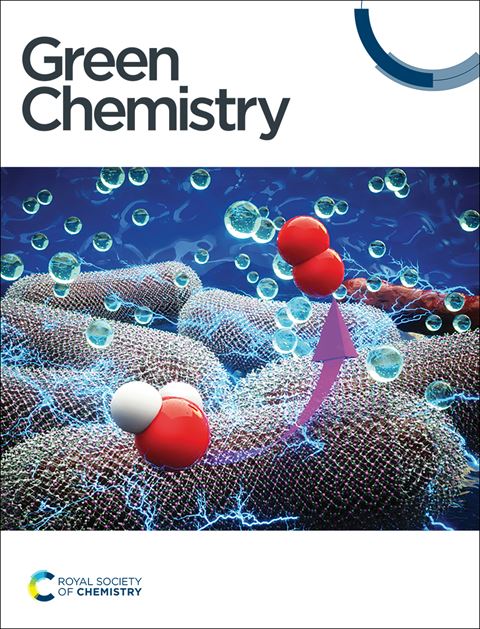实现废石墨绿色高效回收的低温熔盐离子再生策略
IF 9.2
1区 化学
Q1 CHEMISTRY, MULTIDISCIPLINARY
引用次数: 0
摘要
废旧锂离子电池电极材料的回收利用在资源节约和环境保护方面日益受到重视。石墨是商用锂离子电池的主要阳极材料。然而,由于其经济价值低,分离复杂,长期使用会破坏结构,因此废石墨通常被丢弃或焚烧。本研究展示了一种绿色高效的再生废石墨的方法,即在空气气氛中熔融盐离子辅助热处理,从中获得味精样品。在热处理过程中,由于离子快速迁移过程、原子级混合和熔盐环境中的高溶解度,SG中的残余金属离子基本上被去除。同时,石墨的sp3杂化碳和附着的非晶态碳的结构缺陷通过低温氧化工艺得到修复。有趣的是,丰富的纳米通道和CO键的引入促进了Li+的嵌入/脱嵌过程,并为锂的储存提供了更多的活性位点。因此,与商业石墨(CG)和传统加工石墨(CPG)相比,MSG样品作为lib的阳极材料有了显著的改进。在0.1℃下,MSG样品的放电容量高达427.1 mA h g−1,与SG相比增加了141.4 mA h g−1。即使在2.0℃下,经过1000次循环后,MSG的可逆容量也可以达到200.2 mA h g−1。本研究为SG材料的回收利用提供了一条绿色可行的途径,减轻了资源压力和环境危害,同时适合工业应用。本文章由计算机程序翻译,如有差异,请以英文原文为准。
Low-temperature molten salt ion regeneration strategy towards green and efficient spent graphite recycling†
Recovering electrode materials from spent lithium-ion batteries (LIBs) is increasingly valued for resource conservation and environmental protection. Graphite is the dominant anode material for commercial LIBs. However, the spent graphite (SG) is often discarded or incinerated due to its low economic value, complexity of separation, and structural damage by extended use. This study demonstrates a green and efficient method to regenerate spent graphite by a molten salt ion-assisted thermal treatment in air atmosphere, from which a MSG sample can be obtained. During the thermal treatment, residual metal ions from the SG are substantially removed due to the rapid ion migration process, atomic-level mixing and high solubility in the molten salt environment. Meanwhile, structural imperfections in the sp3-hybridized carbons of graphite and the attached amorphous carbons are repaired by the low temperature oxidation process. Interestingly, abundant nanochannels and CO bonds are introduced, which facilitate the intercalation/deintercalation process of Li+ and provide increased active sites for lithium storage. Thus, the MSG sample demonstrated a significant improvement as an anode material for LIBs compared with commercial graphite (CG) and conventionally processed graphite (CPG). A high discharge capacity of up to 427.1 mA h g−1 at 0.1 C could be delivered for the MSG sample, representing an increment of 141.4 mA h g−1 compared with SG. Even at 2.0 C, a reversible capacity of 200.2 mA h g−1 after 1000 cycles can be achieved for the MSG. This work offers a green and feasible approach for recycling SG materials, alleviating resource pressure and environmental hazards while being suitable for industrial applications.
求助全文
通过发布文献求助,成功后即可免费获取论文全文。
去求助
来源期刊

Green Chemistry
化学-化学综合
CiteScore
16.10
自引率
7.10%
发文量
677
审稿时长
1.4 months
期刊介绍:
Green Chemistry is a journal that provides a unique forum for the publication of innovative research on the development of alternative green and sustainable technologies. The scope of Green Chemistry is based on the definition proposed by Anastas and Warner (Green Chemistry: Theory and Practice, P T Anastas and J C Warner, Oxford University Press, Oxford, 1998), which defines green chemistry as the utilisation of a set of principles that reduces or eliminates the use or generation of hazardous substances in the design, manufacture and application of chemical products. Green Chemistry aims to reduce the environmental impact of the chemical enterprise by developing a technology base that is inherently non-toxic to living things and the environment. The journal welcomes submissions on all aspects of research relating to this endeavor and publishes original and significant cutting-edge research that is likely to be of wide general appeal. For a work to be published, it must present a significant advance in green chemistry, including a comparison with existing methods and a demonstration of advantages over those methods.
 求助内容:
求助内容: 应助结果提醒方式:
应助结果提醒方式:


